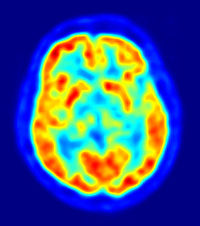Brain science has made huge advances in the past decades, and our understanding of the brain, far from being complete, has increased enormously. These advances have been made possible thanks to the different brain imaging techniques discovered during this last century. In this post we will go through the 4 most awesome of these techniques

Electroencephalography (EEG)
EEG could be considered the father of neuroimaging techniques, since it is the first technique used to measure (electrical) activity of the living brain. Hans Berger recorded the first EEG of a human in 1924. EEG devices have advanced greatly since then, making them more reliable, more portable, with more electrodes and even wireless. EEG interpretation and data analysis techniques have also advanced a long way. Complex EEG data analysis techniques have been developed (a brief overview can be found here), such as the so-called EEG-tomography. With this technique we can make a 3D map of the interior of the brain, just by measuring the electrical potentials in the scalp of the brain.
EEG is cheap, non-invasive, relatively easy to set-up and the time resolution is excellent: down to less than 1 ms or, in other words, lower than the time needed to have an action potential. On the other hand, the spatial resolution of EEG is higher than other brain imaging techniques (about 1-2 cm).
Magnetic Resonance Imagery (MRI)
It represents the Holy Grail in brain imaging techniques as well as for medical imaging in general. MRI is a relatively new technique (the first MRI image was published in 1973). Paul Lauterbur and Peter Mansfield, pioneers in MRI techniques received the Nobel prize for medicine in 2003. Very briefly, MRI uses strong magnetic fields and electromagnetic pulses to excite protons which then generate a photon before decaying to their normal state. These photons are then measured by the MRI and a map of a living tissue can be generated. MRI has great spatial resolution (2-3 mm), which makes it very suitable for both research and clinical applications. The drawback is the temporal resolution, which is quite low (higher than 1 second). Also, MRI equipment is very expensive, bulky and thus not portable and unsuitable for out-of-the lab use.
Near InfraRed Spectroscopy (NIRS)
This is a relatively recent technique: medical and physiological applications have only been developed in the last few decades. The idea is to attach a source of NIR light to the scalp and an NIR light detector. That way the transmission and absorption rate of the NIR light in human tissues can be obtained, which contains information of the changes in haemoglobin concentration. It happens that when a particular area of the brain is active, its oxygen demand increases and thus haemoglobin concentration also increases. NIRS can only get information from cortical tissues, since NIR light is fully absorbed in deeper regions of the brain. Also, NIRS temporal resolution is similar to MRI, since we are obtaining similar information, that is, changes in blood flow. The advantages of NIRS are portability, ease of use and that it is cheap. For those reasons, NIRS has been applied in many Brain Computer Interface (BCI) applications.
Positron emission tomography (PET)
This is a very cool technique in which several physical concepts are applied in order to extract information from the brain: from particle physics to quantum physics. Briefly, the subject under study is injected with a radioactive marker that contains isotopes that will decay into lower energy particles, and in that process will create positrons that will collide with electrons and then transform into photons that can be detected by the PET. Nevertheless, this brain imaging technique is invasive (the subject is injected with a radioactive substance), expensive (to create the radioactive isotope, a sincrotron is needed) and not portable (PET is quite large). On the other hand, the quality of PET images is quite high and is widely used for Brain Tumour detection, among other (clinical) applications.
There are some other interesting neuroimaging techniques, but in order to keep this post short enough, I will just briefly list them:
- Electrocorticogram (EcoG): requires opening the skull and placing an electrode array in the surface of the cortex. It records electrical signals, but of higher quality than EEG.
- Magnetoencephalogram (MEG): Like EEG, but in this case it records the magnetic fields produced by the neurons as they fire.
- Computer Assisted Tomography (CAT): A lot of radiographies are done from many different angles. With this information a 3D image of the brain can be produced. Caution: The radioactivity exposure of the patients is considerable.
- Micro Electrode Arrays (MEAs): Used for in-vitro neurone cultures, it allows to measure individual action potentials, getting access to the more basic communication mechanisms between neurones.
I hope you have enjoyed this broad overview of brain imaging techniques, and if you have any comments please drop a line. See you next time!
Pictures credits: EEG recorded by Hans Berger (Public Domain); Jens Langner (http://www.jens-langner.de/) (Public Domain).




